AMD FX-8370E CPU Review: Vishera Down to 95W, Price Cuts for FX
by Ian Cutress on September 2, 2014 8:00 AM ESTGaming Benchmarks
F1 2013
First up is F1 2013 by Codemasters. I am a big Formula 1 fan in my spare time, and nothing makes me happier than carving up the field in a Caterham, waving to the Red Bulls as I drive by (because I play on easy and take shortcuts). F1 2013 uses the EGO Engine, and like other Codemasters games ends up being very playable on old hardware quite easily. In order to beef up the benchmark a bit, we devised the following scenario for the benchmark mode: one lap of Spa-Francorchamps in the heavy wet, the benchmark follows Jenson Button in the McLaren who starts on the grid in 22nd place, with the field made up of 11 Williams cars, 5 Marussia and 5 Caterham in that order. This puts emphasis on the CPU to handle the AI in the wet, and allows for a good amount of overtaking during the automated benchmark. We test at 1920x1080 on Ultra graphical settings.
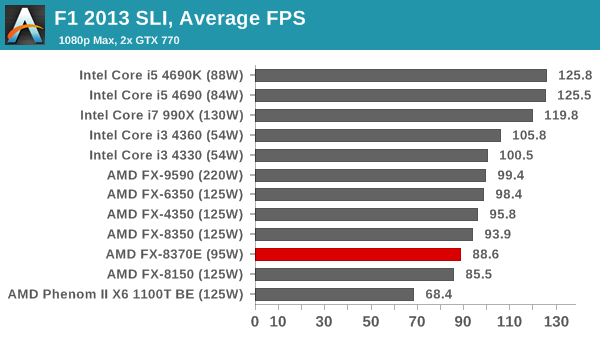
In all combinations, the 8370E and the 8150 duke it out. F1 2013 seems to be an Intel dominated title, given the i3 and outperform the FX-9590.
Bioshock Infinite
Bioshock Infinite was Zero Punctuation’s Game of the Year for 2013, uses the Unreal Engine 3, and is designed to scale with both cores and graphical prowess. We test the benchmark using the Adrenaline benchmark tool and the Xtreme (1920x1080, Maximum) performance setting, noting down the average frame rates and the minimum frame rates.
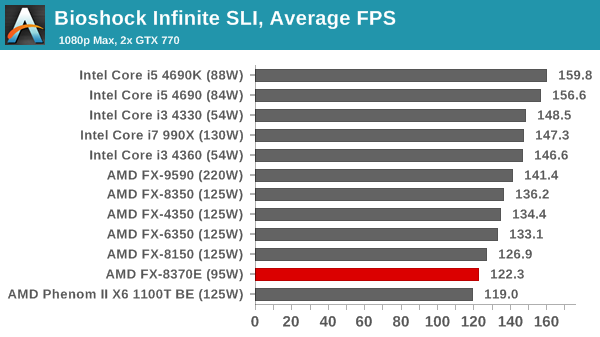
The FX-8350 again fits in just beneath the FX-8150, but for a lower power consumption.
Tomb Raider
The next benchmark in our test is Tomb Raider. Tomb Raider is an AMD optimized game, lauded for its use of TressFX creating dynamic hair to increase the immersion in game. Tomb Raider uses a modified version of the Crystal Engine, and enjoys raw horsepower. We test the benchmark using the Adrenaline benchmark tool and the Xtreme (1920x1080, Maximum) performance setting, noting down the average frame rates and the minimum frame rates.
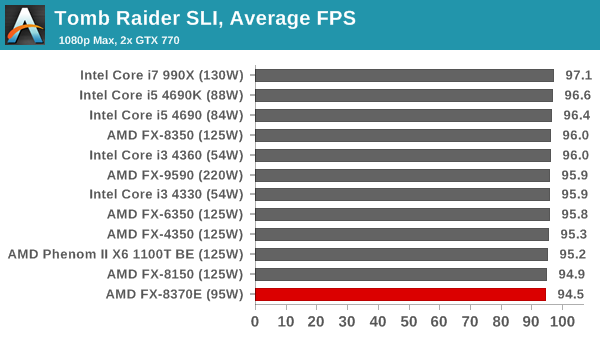
Tomb Raider continues to be CPU agnostic, even around the FX quad thread CPUs.
Sleeping Dogs
Sleeping Dogs is a benchmarking wet dream – a highly complex benchmark that can bring the toughest setup and high resolutions down into single figures. Having an extreme SSAO setting can do that, but at the right settings Sleeping Dogs is highly playable and enjoyable. We run the basic benchmark program laid out in the Adrenaline benchmark tool, and the Xtreme (1920x1080, Maximum) performance setting, noting down the average frame rates and the minimum frame rates.
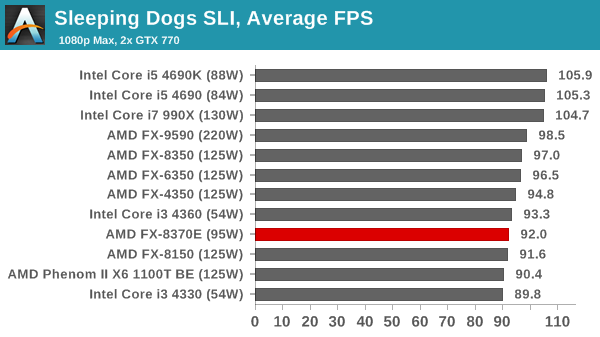
The eight threads offers some advantage in minimum frame rates, but average frame rates are still around the FX-8150.
Battlefield 4
The EA/DICE series that has taken countless hours of my life away is back for another iteration, using the Frostbite 3 engine. AMD is also piling its resources into BF4 with the new Mantle API for developers, designed to cut the time required for the CPU to dispatch commands to the graphical sub-system. For our test we use the in-game benchmarking tools and record the frame time for the first ~70 seconds of the Tashgar single player mission, which is an on-rails generation of and rendering of objects and textures. We test at 1920x1080 at Ultra settings.
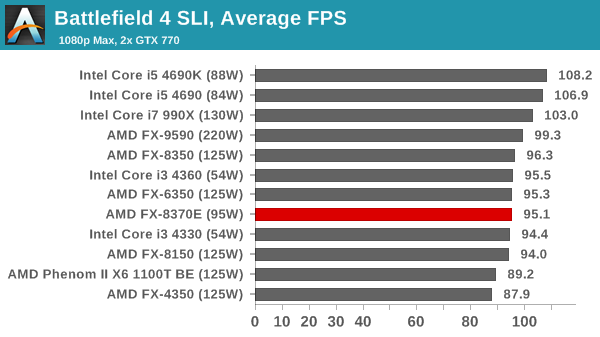
The FX-8370E stretches its legs a little in terms of minimum frame rates, particularly in SLI, however it is handily beaten by the i3-4330.















107 Comments
View All Comments
boot318 - Tuesday, September 2, 2014 - link
AMD, you sure the CPU speed is right? :/Good to see that power consumption is down (would like to get more data on it). I've been wanting to my my Phenom x3 that I have an office computer with an 8-core, and I might just do it with this one. Black Friday!!!!
ddriver - Tuesday, September 2, 2014 - link
Yeah, they fixed power consumption, all they need to do now is double the performance and they are back in the game LOLFlunk - Tuesday, September 2, 2014 - link
Hey, be nice to AMD. These new processors are totally competitive with Intel...'s Sandy Bridge processors from 3 years ago.Seriously AMD, Intel has almost been standing still for 3 years and you're still behind. Come up with something better or us enthusiasts are not going to have a reason to even look at your chips. Your GPUs are a good option, with competitive performance and better prices (I recommend Radeons in almost every price bracket right now because of this). If only AMD could put out some decent CPUs.
SpaceRanger - Tuesday, September 2, 2014 - link
Has anyone been looking at their chips seriously?? I stopped using AMD a long while ago. Intel blew them away and it'll take some competitive chips from AMD to get me to think otherwise.ddriver - Tuesday, September 2, 2014 - link
Don't get me wrong, I sympathize with underdogs, and especially considering in the case of AMD, it was decades of Intel's anti-competitive practices that have pretty much doomed AMD to be a perpetual runner up, but I can't deny the obvious. AMD is where Intel always wanted it to be - a handicapped "competitor", barely enough for Intel to say "we are not a monopoly". I've been a long time AMD consumer, but today it is not worth it, maybe on the low end where power consumption is not that much of an issue and the lower price may make some sense, at least in the short term. But ever since I became a prosumer, AMD CPUs simply have nothing to offer. Radeons are pretty neat though, since they offer tremendously better DP performance for the buck.Seriously, how hard is to make a decent CPU... Intel surely has a manufacturing lead as well, but the poor performance of AMD is mostly because of the inferior design, process might give Intel 20-30% advantage, but the rest is all the design.
On a side note, the CPU performance stalling is actually a good thing, even if AMD was competitive, there are physical limits which CPUs will hit soon, not to mention Intel has already reached the point the chips are too small to displace that much hear efficiently. I remember I used to upgrade CPUs every 18 months or so, but now I have a 2 year old CPU that is only a notch slower than the latest and greatest.
Moore's "law" is a dud, it is obvious that performance cannot exponentially grow, it is more of a half of bell shaped curve, as we reach physical limits, performance gains will slowly go stale. And quite frankly - that's OK, enough is enough. Did we really make much good use of extra performance? Nope, we got sloppy technologies, slow programming languages, bloated runtimes which kind of "equal out" the experience. I have 10 tabs in my browser open, with total content of all websites not exceeding 100 MB, and yet it takes 1200 MB of ram... Lousy skype, a puny messenger - 100 MB of ram usage? WTF?
Death666Angel - Tuesday, September 2, 2014 - link
"not to mention Intel has already reached the point the chips are too small to displace that much hear efficiently."So why is my i7-4770k @ 4.5GHz and 1.35V cooler (60°C core average while running Prime95 27.9, delidded) than my old i7-860 @ 3.8GHz and 1.34V (80°C core average with same load)? It is pretty much just Intel cheaping out on manufacturing of the consumer line CPUs, with weak TIM and too much glue for the IHS.
Death666Angel - Tuesday, September 2, 2014 - link
"Moore's "law" is a dud, it is obvious that performance"Way to show that you don't know jack. Moore's Law just says that the number of transistors on the same area will double every 2 years. Nothing about the performance of said transistors.
mrdude - Tuesday, September 2, 2014 - link
You forgot the economics portion of Moore's law, which ties number of transistors per dollar. If there wasn't a financial incentive, we would have never had the law in the first place ;) Shrinking didn't just improve die sizes (and almost always performance), but it also made economic sense. If you take into account the economic aspect, ddriver isn't far off. We're not far off heretofore hypothetical scenario of 'It's just too expensive and doesn't provide enough benefit anymore'. In fact, for some semicos we're already there.Samus - Wednesday, September 3, 2014 - link
Seriously, to imply that an IPC should double in performance every 24 months is ridiculously impossible.Moore's law is a law of production, not design.
ddriver - Wednesday, September 3, 2014 - link
Even so, that is impossible just as well. This would require that transistors can get infinitely small, which is simply not the case. There are limits to how small a transistor can be, and even in the case of insanely slow and expensive atomic assembly transistors will still be several atoms big, and that won't even make it in mass production.Moore's law IS A DUD and only applies to a short interval in time, Moore apparently didn't look far enough into the future, and made a foolish assumption transistors will keep shrinking perpetually, and even considering how thick chips were back in his days is no excuse for him making such a statement, nor is there any excuse to people who like religious zealots believe it will hold forever.
If you bother to actually map transistor size vs time you will not get a straight line but the half of an inverted bell shaped curve, indicating initially slow transistor shrinking, gradually speeding up towards the middle and gradually slowing down to a complete halt the decade or two.
Something like that: www.futuretimeline.net/subject/images/transistor-size-timeline.gif
however this one starts at the middle.